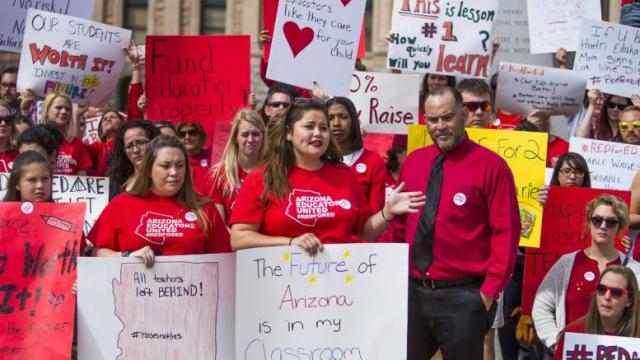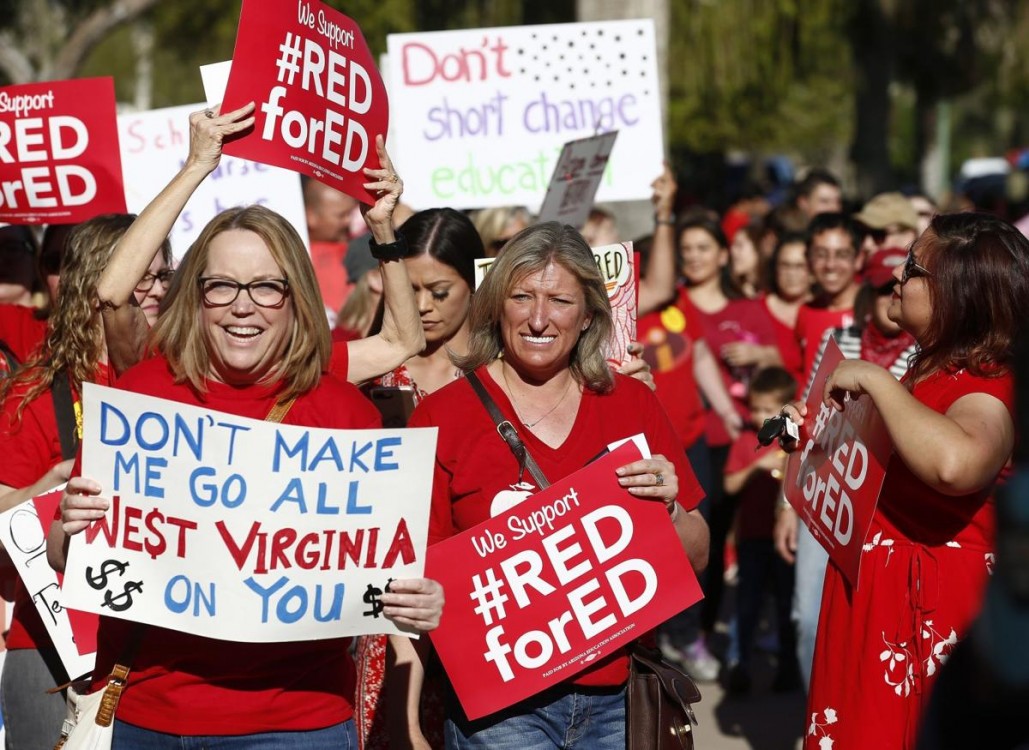
We can add Arizona to the ever-growing list of states where teachers are saying “enough” to state-imposed financial austerity, and walking off the job to protest years of pay cuts, inadequate school resources, and stressful working conditions.
Under the banner of #RedForEd, Arizona teachers voted overwhelmingly (78%) for a statewide walkout – the first in the state’s history – starting April 26, rejecting a bogus offer of a 20% pay increase made by the governor to stave off the walkout.
Like teacher actions in West Virginia, Kentucky, and Oklahoma, the Arizona walkout is a wildcat strike in a Republican-dominated, “right to work” state, which makes the action essentially illegal. Also, as in other states, Arizona has seen massive cutbacks to education funding and teacher pay.
But Arizona also presents new and interesting challenges to the spreading teacher uprisings, and demonstrates ways that teachers build bridges.
Bridges, Not Walls
The teacher workforce in Arizona is significantly more racially diverse than in the other states where walkouts have taken place. While nearly a quarter of Arizona teachers are nonwhite, Oklahoma’s percentage of nonwhite teachers is significantly smaller, and percentages of nonwhite teachers in West Virginia and Kentucky are single-digit.
Further, in Arizona, charter schools make up nearly a quarter of all K-12 publicly funded schools and educate about 17% of students. What will teachers in those schools do?
Like the participants in other teacher uprisings, Arizona’s teachers will likely prove to be bridge builders. As a new report from the Schott Foundation for Public Education explains, the Arizona teacher uprising is yet another example of a powerful new wave of community-labor partnerships that are keeping students first.
Teacher and Communities Together
Teachers who’ve been walking out of schools are taking their grievances beyond the normal confines of partisan politics and labor disputes to decry the dire conditions in struggling communities across the nation. Their ultimate aim is to have an effect at the ballot box. That requires teachers to create strong partnerships with community advocacy groups.
In Arizona, a community advocacy group working with the teachers is Living United for Change in Arizona (LUCHA). LUCHA is a grassroots organization affiliated with People’s Action that advocates for fair housing, voting rights, immigrant services, a $15 minimum wage, and other social and economic justice causes.
I recently spoke with the LUCHA’s executive director Alex Gomez about how her organization is working with teachers.
“People are part of #RedForEd for many reasons,” Gomez says. “What’s so powerful about the movement is that it cuts across so many issues that are important not only for our education system but in our communities too,” she continues. “We’ll be out there on the day of the walk-outs because the teachers’ issues and our issues too. We’re also bringing a contingency of students with us who want to show their support for the teachers and demand lawmakers fund their schools.”
More Than Pay
The most compelling issue mobilizing the walkout is teacher pay. But Gomez says Arizona’s community advocates are also motivated to turn out to denounce the appalling lack of resources in schools and the deteriorating conditions of the buildings.
Labor organizers also see in the teachers’ protests a reflection of their grievance over wage suppression and increasing health care costs. Students see in the protests their chance to address the harsh discipline in schools that push nonwhite students into a school-to-prison pipeline. And communities of color in general see in the teacher strikes opportunities to advocate for culturally-centered curriculum.
The issue of race has generally not been addressed in media reports about teacher actions in other states. So how is that playing out in Arizona, where 50% of the students in K-12 schools are Hispanic, and the state’s overall Latino population is well above 30%?
Teachers of Color
Gomez acknowledges there is a low percentage of teachers of color in these movements – at least as seen in media footage and interviews from huge protests in Kentucky, Oklahoma, and West Virginia. But that’s not because those teachers are not engaged, she argues. It’s just that their presence in the teaching force is disproportionally low compared to the general population.
She believes it’s hard to get communities of color to take on the job of teaching when the salary is so low, especially for those teachers who want to work in their own communities of color. Also, so many college graduates from these low-income communities already have substantial debt burdens, and it’s hard to convince them to take a job like teaching which has substandard pay.
But Gomez asserts that teachers of color are welcome in the movement and are engaged and committed to the walkouts. “All educators are banding together in this movement, regardless of race,” she says.
Arizona’s high percentage of teachers working in charter schools also could pose a potentially divisive issue in the walkouts. In West Virginia and Kentucky there are no charter schools, and in Oklahoma, where charters arrived relatively recently, less than 2% of students attend them.
But Gomez says charter school teachers are part of the #RedForEd movement too. After all, they’re also underpaid. “Educators across the board understand there are dollars out there to pay teachers what they deserve,” she states.
Community and Labor Working Together
Collaborations among teachers and community organizations are deliberate and intentional and have a historical development that proceeds what’s happening now.
A recent report from the Schott Foundation for Public Education explains the general principles of building relationships across labor and community organizations to work together to address systemic policy issues related to race, income, and social and education justice.
The report, “Keeping Students First: Building Community Labor Partnerships for Strong Schools,” includes case studies of St. Paul, MN and Austin, TX, where unions and community groups succeeded by bringing each other into strategic development and partnership. [Disclosure: Schott is a longtime partner of People’s Action’s education project.]
“Too often siloed and kept at arm’s length from each other,” writes Schott CEO John Jackson in the report’s introduction, “organized educators, student organizers, and organized communities hold much in common and, when brought together in a spirit of equal partnership and respect, can wield a power greater than the sum of their parts.”
The report argues, “Community labor partnerships build the voice and power of all parties and make it harder for officials to ignore the argument coming from a strong united front.”
Using the case studies from Austin and St. Paul, the authors describe how creating these collaborations relies on building meaningful relationships among stakeholders in the community and adopting an expansive view of what affects the community and thus, its students.
The fact that teachers’ union membership often includes proportionally fewer teachers of color than the communities they serve, the report contends, shouldn’t be an obstacle to building the power of all parties and make it harder for officials to ignore the demands of the whole community.
Teachers who are organizing these statewide rebellions have clearly learned these lessons, and they’re living proof of the report’s finding that “it’s tough for those in power to penetrate these alliances.”















